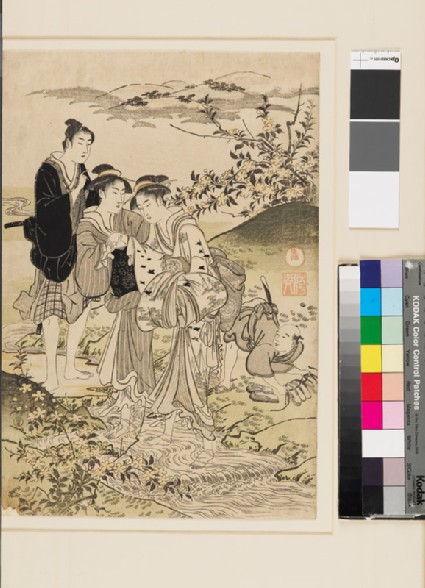Browse: 1264 objects
- Reference URL
Actions
Part of...
Samurai watching women paddling in the Jewel River of Ide
-
Details
- Series
- The Six Jewel Rivers
- Associated place
- Date
- c. 1787 - 1788
- Artist/maker
-
Kubo Shunman (1757 - 1820) (designer)
- Associated people
-
Fushimiya Zenroku (active c. 1787 - 1792) (publisher)Daikandō (active 1740s - c. 1914) (publisher)
- Material and technique
- woodblock, printed with water-based vegetable pigments
- Dimensions
-
mount 55.7 x 34 cm (height x width)
print 37.5 x 25.4 cm (height x width)
- Material index
- Technique index
- Object type index
- No. of items
- 1
- Credit line
- Presented by Mrs Allan and Mr and Mrs H. N. Spalding, 1952.
- Accession no.
- EAX.4090.a
-
Further reading
Oxford: Ashmolean Museum, 24 August-30 November 2005, Beauties of the Four Seasons, Mitsuko Watanabe, ed. (Oxford: Ashmolean Museum, 2005), no. 23 on pp. 46-47, illus. p. 49
Glossary
vegetable pigments
-
vegetable pigments
Vegetable pigments were used to create coloured dyes for Japanese prints, paintings, and textiles. These pigments often faded over time due to the chemical reactions they underwent.
Location
-
- currently in research collection
Objects are sometimes moved to a different location. Our object location data is usually updated on a monthly basis. Contact the Jameel Study Centre if you are planning to visit the museum to see a particular object on display, or would like to arrange an appointment to see an object in our reserve collections.
Publications online
-

Beauties of the Four Seasons
Kubo shunman was a pupil of Kitao Shigemasa (1739-1820) and produced relaxed and elegant colour prints influenced by Kiyonaga. He was particularly adept at the use of muted colour schemes (benigirai) in the time when the government passed sumptuary regulations during the Tenmei and Kansei periods (1781-1800) forbidding the use of bright colours. 'The six jewel river' is one of the finest works by Shunman. The six rivers are all in different areas of Japan but Shunman’s six rivers from the Mutamagawa series is shown here as a continuous image. The collection of the Ashmolean Museum lacks the fifth image, that of Ogi of Shiga.
This print is Ide no Tamagawa (the Jewel River of Ide). In what is probably the end of summer or early autumn, a young samurai is watching a beauty who is being helped by her maid to get into the river to paddle, while a servant ties together their zōri (sandals). The river is particularly known for its clear shallow waters and the abundant yamabuki (Japanese rose).
© 2013 University of Oxford - Ashmolean Museum


